2016 YAMAHA YZ250X MXA RACE TEST: EVERYTHING YOU NEED TO KNOW
Q: IS THE 2016 YAMAHA YZ250X BETTER THAN THE 2015 YZ250X?
A: Of course it is, because there has never been a YZ250X before. Well, that’s not entirely true. Yamaha made a WR250 two-stroke from 1989 to 1996. It had many of the traits of the 2016 YZ250X. Why did they stop making the WR250? The WR250 was heavy and less powerful than the YZ250, so many racers opted to convert a YZ250 into an offroad bike by putting on an 18-inch rear wheel, bigger tank and flywheel weight. When KTM threw all of its effort into building its EX and XC offroad models, with countless models in every displacement, the WR250 went out of fashion. Last year, Yamaha began to fight back against the KTM juggernaut by releasing the 2015 YZ250FX four-stroke. This year the Blue Cru has added the YZ250X two-stroke and YZ450FX four-stroke.
Q: HOW MUCH DOES THE YAMAHA YZ250X COST?
A: The 2016 YZ250X is $100 more than the YZ250, $9 less than the KTM 250SX and $1100 less than a KTM 250XC. The suggested retail price is $7390.
 2016 Yamaha YZ250X: Equipped with a mellow engine, softer suspension and a wide-ratio gearbox, the 2016 Yamaha YZ250X is built for cross-country racing, but has a motocross pedigree.
2016 Yamaha YZ250X: Equipped with a mellow engine, softer suspension and a wide-ratio gearbox, the 2016 Yamaha YZ250X is built for cross-country racing, but has a motocross pedigree.
Q: WHY IS MXA TESTING AN OFFROAD BIKE?
A: Two reasons:
(1) We love two-strokes.
(2) The Yamaha YZ250X can be ridden in the desert, woods, enduros and on trails. And, as the MXA wrecking crew hoped to prove, it can be raced in motocross as well.
Q: WHY NOT JUST CONVERT A YZ250 TO AN OFFROAD MODEL LIKE RACERS HAVE BEEN DOING FOR YEARS?
A: You could, but for riders who focus more on offroad riding than motocross, Yamaha added enough offroad parts to make the YZ250X lean and mean. That includes softer suspension, a wide-ratio transmission, kickstand and 18-inch rear wheel.
Q: HOW DOES THE 2016 YZ250X DIFFER FROM ITS YZ250 BROTHER?
A: Although the basic platform is all YZ250, there were quite a few changes to make the YZ250X more offroad-worthy.
(1) Cylinder head and cylinder. The head volume was increased by 2.1cc from 21.5cc to 23.6cc. This added volume reduced the compression ratio from 8.9:1 to 7.9:1. The exhaust port height was raised 0.5mm, and the power valve shape was updated to match the exhaust port height.
(2) Pipe. The YZ250X expansion chamber is totally new but not completely different. Essentially, it is designed to tuck in tighter to keep the vulnerable cones away from tree stumps and rocks. The pipe is narrower by 35mm.
(3) CDI. The CDI timing has been delayed in the mid-to-high rpm for a broader and more gentle pull.
(4) Transmission. Both first and second gears have the same ratios as the YZ250, but third is closer to second, fourth is further away and fifth is in another dimension. The YZ250 and YZ250X share the same 14/50 final gearing. With first and second gears being identical to the YZ250 ratios, the lower third gear on the YZ250X would be like adding one tooth, while fourth gear would replicate being two teeth taller and fifth gear an amazing five teeth taller.
(5) Clutch. The clutch spring rate has been reduced by 10 percent for easier lever pressure. Pressure is 20% less at the lever because of the cam on the actuating are has been changes as has the leverage ratio on the clutch perch. While the clutch basket remains unchanged from the YZ250 to the YZ250X, the inner hub has had the holes eliminated to optimize oil flow and the 5 friction plates are made from a different material formula.
(6) Shift stopper lever. The shift stopper lever has a support arm added for more positive shifting.
(7) Suspension. The X offers the same industry-leading Kayaba SSS components as the YZ250, including the same spring rates front (4.3 N/m) and rear (48 N/m). The only thing that’s changed is that the internal shim stacks have been valved softer for better trail compliance.
(8) Gas tank. The X has the same fuel capacity as the YZ250, but the X offers a reserve fuel valve that kicks in when 0.5 gallons are left in the tank.
(9) Rear wheel. A terrain-specific 18-inch rear wheel with Dunlop Geomax AT81 offroad terrain tires was spec’ed on the YZ250X for better grip on rocks, roots and muddy water crossings.
(10) YPVS timing. The Yamaha Power Valve System’s (YPVS) governor spring and preload settings open sooner.
(11) Bolt-on parts. The X comes standard with a D.I.D. O-ring chain and spring-loaded aluminum side stand.
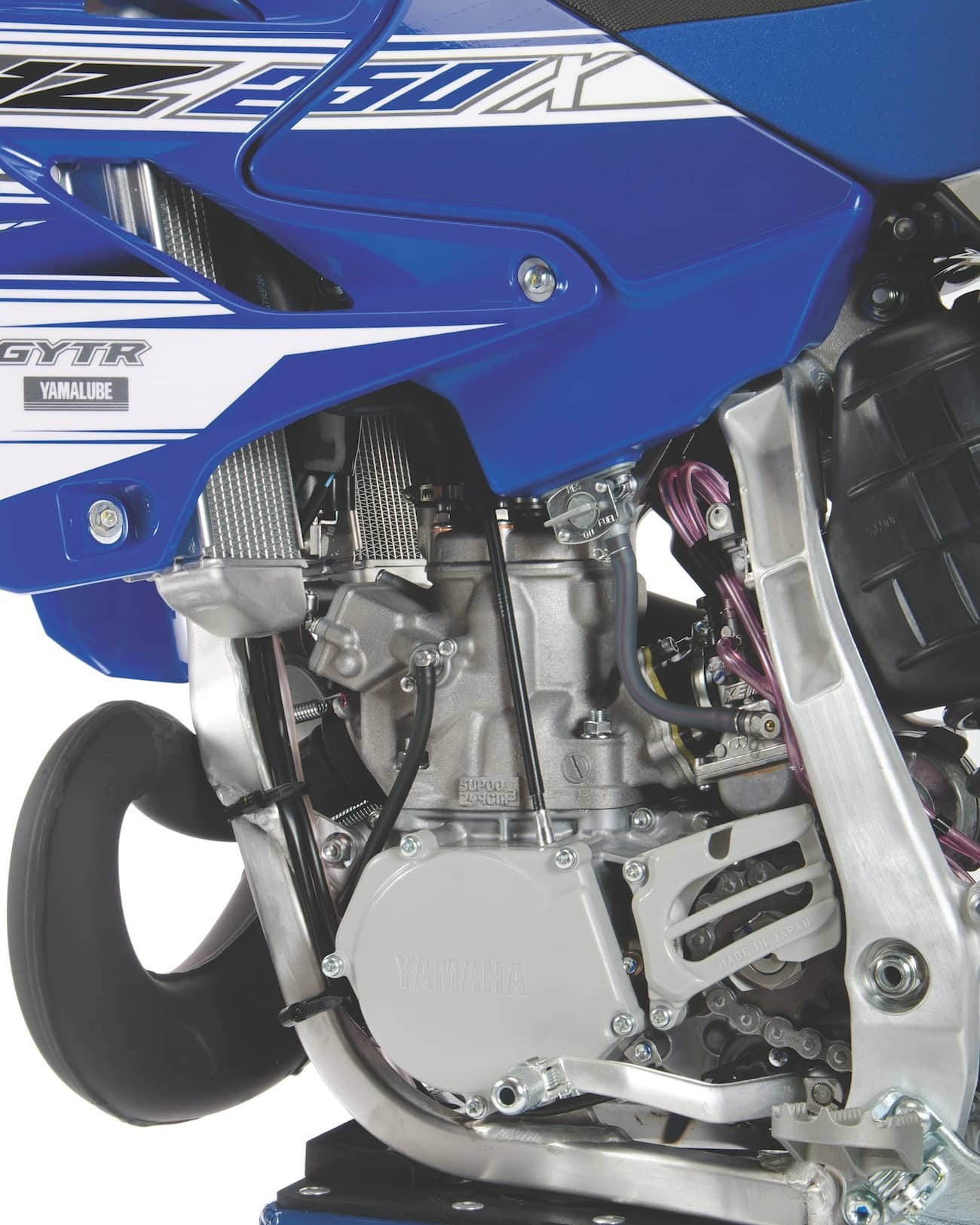 Ratio right: The YZ250X has the same first and second gears as the YZ250, but third is a little closer. This was a big plus.
Ratio right: The YZ250X has the same first and second gears as the YZ250, but third is a little closer. This was a big plus.
Q: HOW GOOD ARE THE YZ250X’S GEAR RATIOS?
A: We have always felt that third gear on the YZ250 was too far away from second. When you shift from second to third on the YZ250, there is often a little bog. The tighter second-to-third gear ratios on the YZ250X eliminate any doubt about the effectiveness of first, second and third gears. It does however, make the upshift from third to fourth a little more critical. On tight tracks, the MXA test riders found that the jump to fourth gear wasn’t hard to make as long as you revved third all the way to peak before shifting up. As for fifth gear, what can we tell you? It was way up there, and once in fifth, the YZ250X felt like a Cadillac Eldorado in overdrive. We considered the YZ250X’s fifth gear to be a Baja gear.
To answer the question, from first to third gear we liked the YZ250X transmission more than the stock YZ250 gearbox; but, when we were in fourth gear or higher, the YZ250 was much better suited to riding on tracks.
Q: IS THE YZ250X FASTER THAN THE YZ250?
A: No. In terms of pure speed and horsepower, Yamaha’s engineers weren’t looking to build a fire-breather. Instead, the YZ250X gives up brute strength with its lower compression ratio and milder mapping for a more usable two-stroke-style of power.
Q: HOW WAS THE YZ250X ON OFFROAD TERRAIN?
A: Everybody loved the bike. Its perky low-to-mid powerband was great for tight trails and big hills. For more open trail riding we could just click it into fourth or fifth and cruise. The softer suspension absorbed rocks without deflection and was planted on slick terrain. There wasn’t much to dislike about this bike offroad.
Q: CAN YOU MOUNT A 19-INCH REAR WHEEL TO THE YZ250X?
A: We wanted to switch the 18-inch rear wheel that was mounted with a Dunlop Geomax AT81 tire to a 19-inch. Not because we didn’t like the 18-inch tire on the motocross track, but because we had more experience with the selection of tire brands available in a 19-inch size.
Can you mount a 19-incher on the YZ250X? Yes, but it’s not as easy as swapping rear wheels. The YZ250X’s 18-inch rear wheel comes with a 22mm axle, while the YZ250’s 19-inch rear wheel has a 25mm axle. So, if you wanted to make the swap, you would not only have to purchase a complete 19-inch rear wheel, you would also have to buy the 25mm axle, wheel spacers, brake carrier and axle blocks. There is a cheaper way. The best solution is to buy a 19-inch rim and longer spokes (YZ250 two-stroke spokes work) and lace the rim and spokes to the stock X hub.
Q: WHAT DID WE DO WITH THE GEARING?
A: The MXA wrecking crew knew that finding the perfect gearing was going to be impossible due to the wide-ratio gearbox. But, the question at hand was whether to go down on the gearing to make fourth gear more usable or go up on the gearing and spread first through third farther apart (and never touch fourth ever again). Some MXA test riders liked going from a 50- to a 51-tooth rear sprocket. They were willing to live with tighter gaps between first, second and third to bring fourth into play. This made the powerband more aggressive. When we tried a taller 14/49 ratio, it took away the aggressive edge and spread out the gap between the first three gears while requiring some clutch work to make the jump to fourth. In the end, most MXA test riders opted for the stock 14/50 gearing.
 Cheater: The quickest way to identify a YZ250X is by the aluminum kickstand. We aren’t ashamed that we loved it.
Cheater: The quickest way to identify a YZ250X is by the aluminum kickstand. We aren’t ashamed that we loved it.
Q: WHAT ABOUT THE KICKSTAND?
A: We’d be lying if we didn’t say that we liked it. Every MXA test rider was afraid that it would bounce down when landing from big jumps, but we had no such issues. It was quite nice to come in from a ride, flip the stand down and walk away. Yes, we are that lazy. But, since all motocross racing organizations ban kickstands, we removed it for races (if they caught us using it).
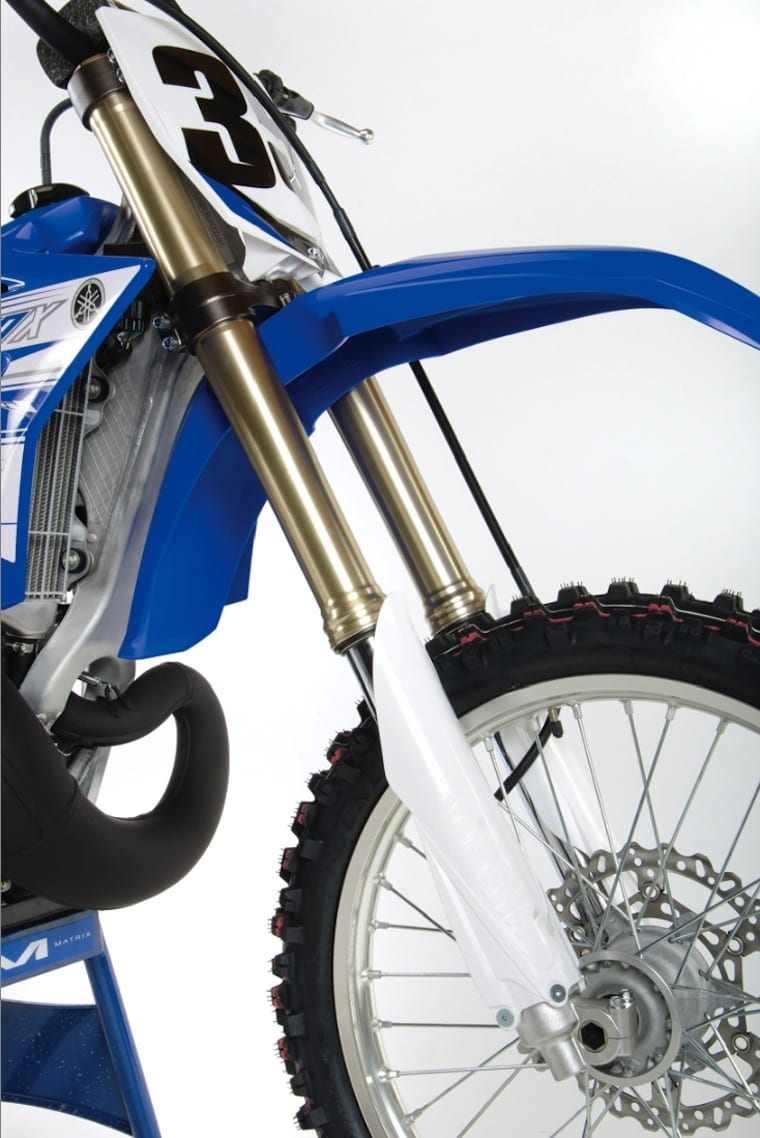 Stepchild: The YZ250X forks are not junk forks from the left-over parts bin. They are true-to-life Kayaba SSS forks.
Stepchild: The YZ250X forks are not junk forks from the left-over parts bin. They are true-to-life Kayaba SSS forks.
Q: HOW DID WE LIKE THE OFFROAD SUSPENSION SETTINGS FOR MOTOCROSS?
A: No surprise. It was soft, but we already figured it would be. It rode low in the stroke and had a harsh feeling on the consecutive chatter of a motocross track. But, the great thing is that it never felt like it bottomed. We did a band-aid fix that made all the difference in the world. We added 10cc of oil to each fork leg, which helped keep the forks out of the harshest part of the stroke. Yes, it was too soft for Pro riders or tracks with big jumps, but we were still able to cut competitive lap times on the YZ250X. And many of our Vet test riders felt that the YZ250X suspension setup favored their speed more than the YZ250 forks.
Q: CAN YOU RACE MOTOCROSS ON A 2016 YAMAHA YZ250X?
A: Yes. The milder hit and tractable pull of the engine, along with the ultra-plush suspension, make the YZ250X a better motocross bike for Novices, Vets and riders who want to do double- or triple-duty on the same bike. One caveat: If you buy a YZ250X and port the cylinder, mill the head and add an aftermarket exhaust, you might as well buy a YZ250 and save $100.
 Fuel miser: Although Yamaha didn’t put a larger gas tank on the YZ250X, they did add a reserve valve to get you home.
Fuel miser: Although Yamaha didn’t put a larger gas tank on the YZ250X, they did add a reserve valve to get you home.
Q: WHAT DID WE HATE?
A: The hate list:
(1) Front brake. For 2016, Yamaha upgraded its YZ-F line with 270mm front rotors. It needs to do the same with its two-stroke line. The stock 250mm rotor is weak.
(2) Fifth gear. A large number of our test riders never got to fifth gear. It is way up there.
(3) Gas tank. On a motocross track, we loved that we didn’t have to deal with a bulky, oversized gas tank, but the stock YZ250 gas tank is too small for long trail rides. Yamaha dropped the ball with this crucial item, but the aftermarket will pick it up and run with it. We wish Yamaha had found room for more fuel on the showroom floor.
(4) Electric starter. We love KTM’s push-button electric start on its 250XC offroad bikes. Kicking the YZ250X on the side of a hilly canyon, not so much.
(5) Clutch. It should be noted that we run stiffer clutch springs on our YZ250 two-strokes, so we are pretty sure that we will need stiffer springs on the softer YZ250X clutch. The difference between an YZ250 clutch and X clutch are as follows: 1. The clutch basket is not changed. 2. The number of springs is still five, but the X springs are 10% softer. 3. The inner hub is different, but only to the extent that the holes have been eliminated to reflow the oil. 4. The friction plates have a different pad material on them. 5. The clutch actuation arm’s cam profile is changed to make the clutch pull easier. This, along with the softer springs and a slight change in the clutch lever ratio, produces a clutch that is 20% easier to pull.
(6) Flywheel weight. Yamaha’s engineers depended on the mellower compression ratio to make the YZ250X easier to ride and more tractable. We, and most offroad riders, prefer to run a heavier flywheel weight to improve the churn.
 Skinny Minnie: Yamaha redesigned the YZ250 expansion chamber so that it would tuck in tighter on the YZ250X.
Skinny Minnie: Yamaha redesigned the YZ250 expansion chamber so that it would tuck in tighter on the YZ250X.
Q: WHAT DID WE LIKE?
A: The like list:
(1) Third gear. Bringing third gear closer to second has been on our YZ250 wish list for many years. Now that our prayers have been answered on the X, we hope to see the change on the YZ sometime in the near future.
(2) Suspension. Mechanically, the suspension components are the same class-leading Kayaba SSS units—but with softer valving.
(3) Engine. Although the venerable YZ250 powerplant has grown long in the tooth, it still offers nice, manageable power. But, if Yamaha wants to keep up with the competition, it needs to start bumping up the ponies.
(4) Maintenance. Anybody with a modicum of mechanical skill can keep a YZ250 two-stroke running.
(5) Parts. Even if the YZ250 parts cost the same as their four-stroke nephews, which they don’t, there are a lot fewer of them to buy. The MXA wrecking crew doesn’t believe that two-strokes are more reliable than four-strokes—only that when unreliability rears its ugly head, a two-stroke owner spends less dough on pistons, rings and gaskets—and can put them in himself.
(6) The bike itself. It has been a long time since the Japanese manufacture has made an offroad two-stroke this good.
Q: WHAT DO WE REALLY THINK?
A: This is a jack-of-all-trades bike. You could race a three-hour GNCC race, take a leisurely trail ride through the woods, and when you got to your local motocross track, you could bust some moves. The 2016 Yamaha YZ250X is a very versatile machine. Maybe it’s not as well-spec’ed for offroad riding as its orange competition or as good at motocross as it blue brother, but Yamaha’s YZ250X two-stroke and YZ250FX/YZ450FX four-strokes are watermark machines. They signal that Yamaha is serious about dirt bikes again.
MXA’S YAMAHA YZ250X SETUP SPECS
This is how we set up our 2016 Yamaha YZ250X for the motocross track, since the stock settings were close to perfect for offroad conditions. We offer these setting to help steer you in the right direction.
KAYABA SSS FORK SETTINGS
Most MXA test riders stayed close to the stock clicker settings (after we added 10cc of oil to each fork leg), with the faster riders going in two to five clicks. For hard-core racing, we recommended this setup for the 2016 Yamaha YZ250X (stock specs are in parentheses):
Spring rate: 4.3 N/m
Compression: 9 clicks out (13 clicks out)
Rebound: 10 clicks out
Fork-leg height: 5mm
Notes: The SSS components never feel like they bottom. They do, but they don’t feel like it. Thiswas a huge confidence booster for all conditions. For motocross we added 10cc of oil to each fork leg, which is exactly what we did on our Yamaha YZ250FX four-stroke.
KAYABA SSS SHOCK SETTINGS
Our testers liked the movement on the shock but felt that it was a bit under-damped. They went in a few clicks with the rebound and compression to slow it down and keep it up in the stroke. For hard-core racing, we recommend this shock setup for the 2016 Yamaha YZ250X (stock specs are in parentheses):
Spring rate: 48 N/m
Race sag: 100mm
Hi-compression: 1-5/8 turns
Lo-compression: 9 clicks out (12)
Rebound: 9 clicks out (11)
Notes: The shock is the same as the YZ250’s, including the spring rate. The only thing different is the shim stack, which can be firmed up with compression and rebound clicks.


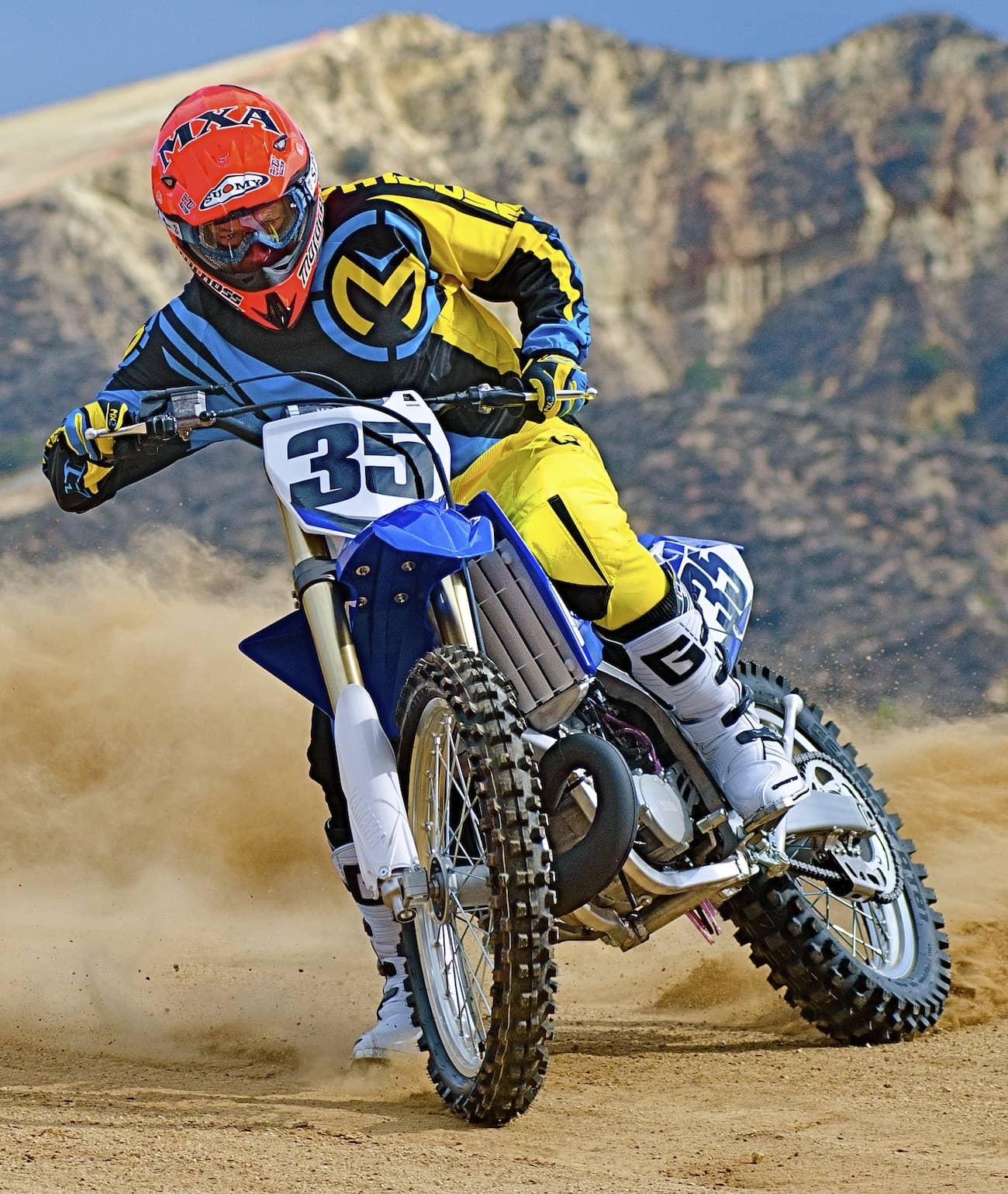
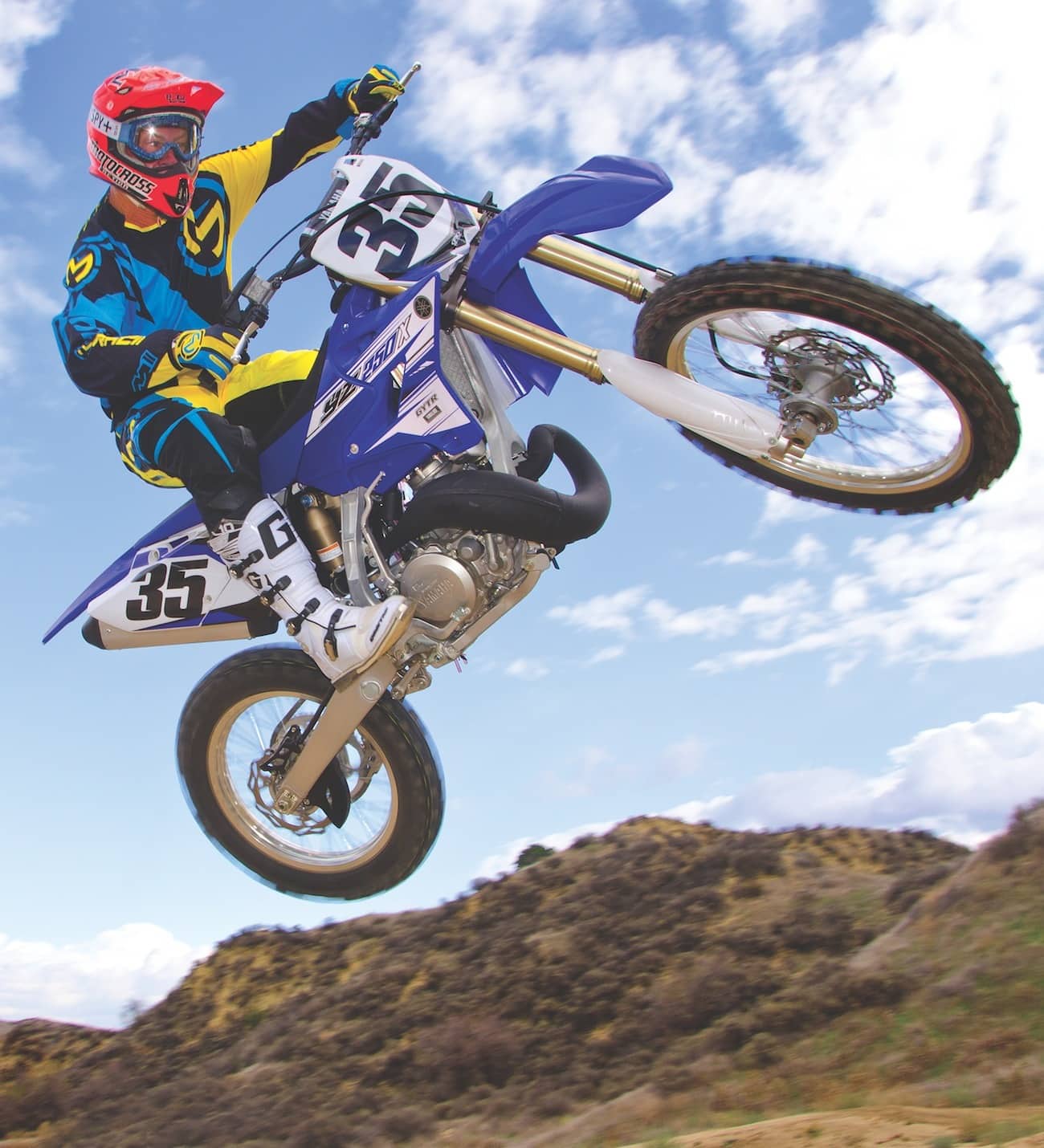





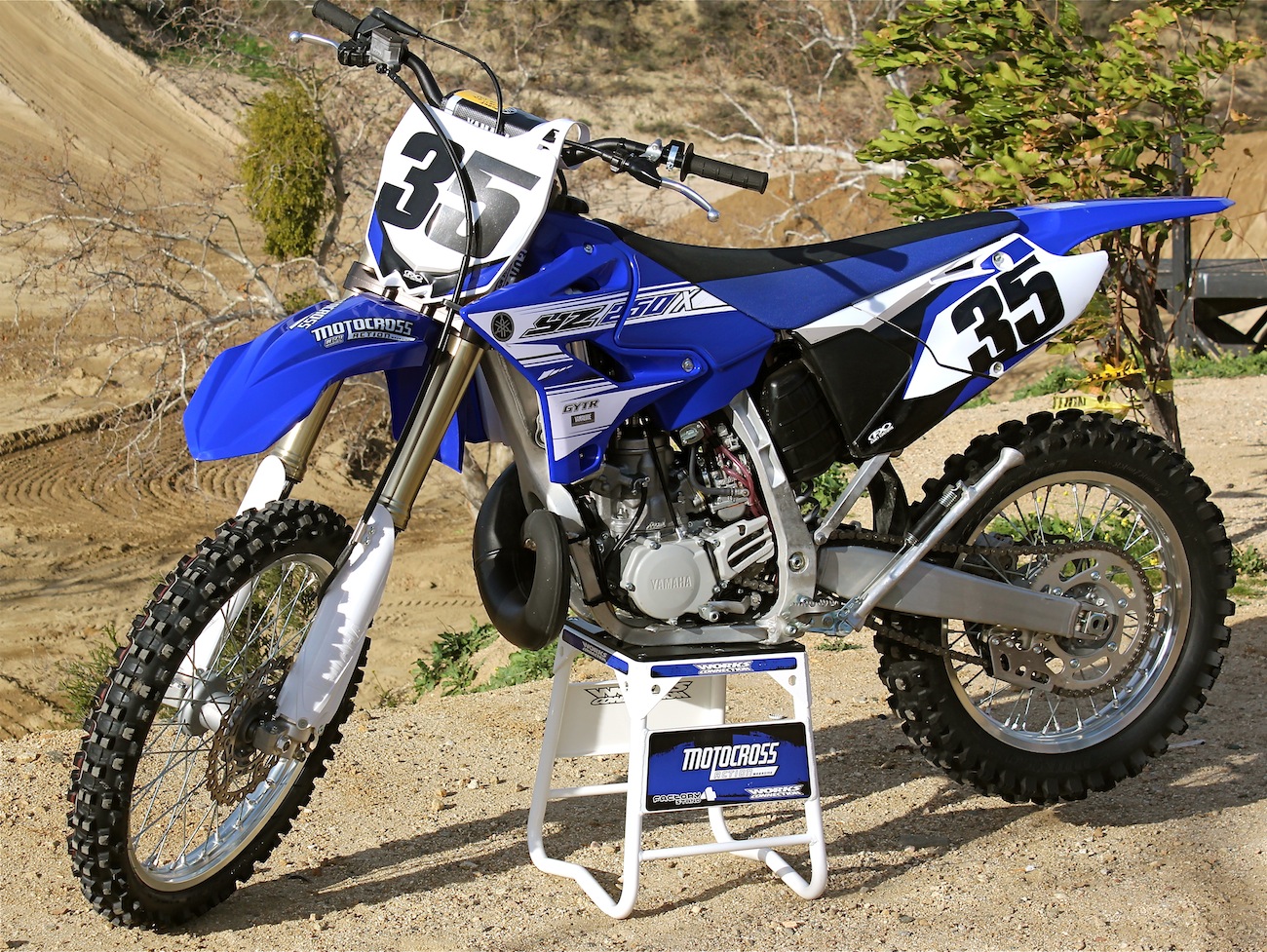



Comments are closed.